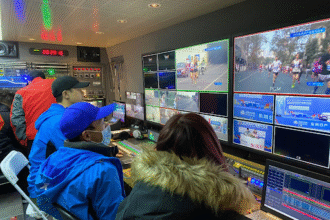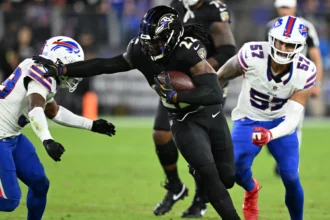Introduction to Post Touchdown Attempt
The roar of the crowd fades into a buzz of anticipation as the team crosses into the end zone. A touchdown scored, jubilation erupts—but that’s just half the battle. The post touchdown attempt is where strategy meets execution and can make or break a game’s momentum. Whether it’s going for an extra point kick or attempting a two-point conversion, this critical moment demands precision and skill. Teams prepare meticulously behind closed doors, but what are they really thinking during these crucial seconds? Join us as we delve deep into best practices for post touchdown attempts, exploring strategies, risks, and why every second counts in those electrifying moments on the field.
What Are the Risks of a Failed Touchdown Attempt?
A failed touchdown attempt can have significant repercussions for any team. The immediate risk is the lost opportunity to score, which can shift momentum in a game. When a team fails to convert, it often leaves players and fans feeling deflated.
In addition to emotional setbacks, there are strategic implications. Opponents gain advantageous field position if they take over on downs. This not only boosts their confidence but also puts pressure on the defensive unit of the failing team.
Furthermore, repeated failures at crucial moments may damage a team’s reputation and morale over time. Players might second-guess themselves during future attempts or lose trust in their coaching staff’s decisions.
Injuries are another concern; high-pressure situations can lead to aggressive plays that increase the chance of player harm. Each failed attempt carries risks that extend beyond just points on the scoreboard.
A Comprehensive Guide to Post-Touchdown Attempts
A post touchdown attempt is a critical moment in any football game. It can determine the outcome of a match and significantly impact team morale.
Teams have two primary options: the extra point kick or the two-point conversion. Each choice carries its own strategies and risks, shaping how teams approach this phase.
Coaches often analyze statistics and situational factors when deciding which route to take. Weather conditions, field position, and even player fatigue come into play.
Communication is vital during these attempts. Players must understand their roles clearly to execute smoothly under pressure.
The kicker plays an essential role as well, requiring precision and focus. Meanwhile, blockers must be ready to fend off defenders for optimal protection.
Mastering the nuances of post-touchdown attempts can elevate a team’s performance significantly.
The Ultimate Guide to Posting a Touchdown Attempt
When it comes to the post touchdown attempt, preparation is key. Teams must execute with precision and timing after scoring a touchdown. Every second counts as players transition from celebration to strategy.
Coaches often outline specific plays for extra points or two-point conversions. Knowing when to go for one or two can make all the difference in a close game.
Players need to understand their roles clearly, whether they are blocking, snapping, or kicking. Communication on the field can’t be overstated; it’s vital for success.
The element of surprise can also play a crucial role here. A well-timed trick play might catch the defense off guard and lead to an easy score.
Practice makes perfect. Repetition during training ensures that every player knows their responsibilities under pressure situations like these.
Understanding the Rules and Regulations
Understanding the rules and regulations surrounding a post touchdown attempt (PTA) is crucial for teams. The NFL has specific guidelines that dictate how these attempts should be executed.
After scoring a touchdown, teams have the option to go for either one point from the two-yard line or two points from the 15-yard line. This decision can significantly impact game momentum.
Additionally, timing plays an essential role. Teams must execute their play within a designated time frame to avoid penalties.
The defense also has its own set of rules during this phase. They cannot interfere with players attempting to kick or pass, making it vital for both sides to know their limits.
Being aware of potential infractions can prevent costly mistakes that could change the game’s outcome. Understanding these nuances enhances strategic planning and execution during critical moments on the field.
Key Players Involved in a Post Touchdown Attempt
During a post touchdown attempt, several key players take center stage. The kicker is the most visible figure, responsible for executing the extra point or two-point conversion. Precision and nerves of steel are vital here.
The snapper plays an equally crucial role. This player delivers the ball to the holder with pinpoint accuracy. A missed snap can derail even the best attempts.
Next is the holder, who receives that perfect snap and sets up the kick. Timing is everything; any hesitation can affect success.
Offensive linemen protect against potential blockers from opposing teams. They form a wall to give their kicker space to work his magic.
Each player’s contribution matters significantly in determining whether a team adds those critical points after scoring. Working together seamlessly creates opportunities for success on every post touchdown attempt.
Common Strategies Used by Teams
Teams employ various strategies during a post touchdown attempt to maximize their chances of success. One common approach is the traditional extra point kick, where the offense lines up for a short field goal. This method relies heavily on precision and teamwork.
Another strategy gaining traction is the two-point conversion. Here, teams opt to run or pass from the two-yard line, aiming for an immediate payoff rather than settling for just one point. This high-risk tactic can shift momentum dramatically.
Some squads focus on deception through misdirection plays that confuse defenders. By faking a play in one direction while executing another, they create openings that can lead to scoring opportunities.
Additionally, utilizing formations like spread or heavy sets allows teams to match up against specific defensive schemes effectively. Each strategy aims not just at points but also at building confidence and enhancing team morale after crossing into the end zone.
Best Practices for a Successful Post Touchdown Attempt
Executing a successful post touchdown attempt requires precision and teamwork. Teams must communicate effectively before, during, and after the play. This ensures everyone knows their role.
Preparation is key. Practice scenarios regularly to build confidence under pressure. Coaches should simulate game conditions to help players adapt quickly.
Choosing the right formation can make a difference too. A well-structured alignment maximizes scoring chances and minimizes defensive counters.
Timing is critical in execution. Players need to synchronize their movements seamlessly for optimal results while avoiding penalties that could cost points.
Mental toughness plays a crucial role as well. Players should remain focused despite distractions from fans or opponents, keeping their eyes on the goalposts ahead.
Adjusting strategies based on opponent tendencies can give teams an edge in high-stakes situations when every point matters most.
The Importance of Special Teams in PTA
Special teams play a crucial role in post touchdown attempts. They are the unsung heroes that can make or break the outcome of these pivotal moments.
The kicker is often under immense pressure during these attempts. Their ability to convert after a touchdown can significantly influence the game’s momentum. A successful kick builds confidence, while a miss can lead to doubt among players and fans alike.
Moreover, special teams coordinators devise intricate strategies tailored to each opponent. These plans include formations and plays designed to exploit weaknesses in the opposing team’s defense.
Additionally, communication is vital within this unit. Every player must understand their responsibilities clearly to ensure seamless execution when it matters most.
Having a strong special teams squad creates an edge that enhances overall performance on field goals or extra points following touchdowns.
Conclusion
The post touchdown attempt is a critical phase in any football game. Understanding its nuances can greatly influence the outcome of a match. By being aware of potential risks, teams can better prepare and strategize for success.
Effective communication among key players is essential during this phase. Coaches must ensure that their team understands the rules and regulations governing post touchdown attempts to avoid unnecessary penalties or mistakes. Developing common strategies tailored to each game situation will enhance a team’s performance.
Special teams play an integral role in executing successful post touchdown attempts, whether it’s converting an extra point or attempting a two-point conversion. Fostering synergy within these units is vital for maximizing scoring opportunities.
Teams that prioritize best practices—such as analyzing opponent tendencies, adjusting formations, and maintaining discipline—are more likely to achieve favorable outcomes following touchdowns. The combination of preparation, strategy, and teamwork can make all the difference when it comes time to capitalize on those crucial moments after finding the end zone.

















